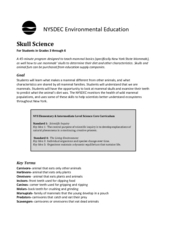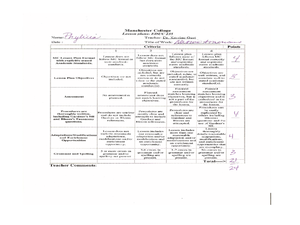Curated OER
Copy Cat
Students follow the directions as the "cat" guides them in moving creatively. In this observing and listening lesson, students move their bodies while staying in their own spaces. Students then are allowed to move out of their space and...
Curated OER
Water: H2O = Life
In this earth science worksheet, students explore and describe animals and their adaptations, including their habitats, physical characteristics, and competing organisms. They also explore and describe how others use water around the...
Curated OER
Water Polo
Twelfth graders warm-up and practice passing drills in groups of four or five before being divided into teams for a full court game of Water Polo. Students are observed during practice for how well they work as a team.
Curated OER
Forehand Clear Shot
Students practice their badminton skills while trying to achieve the three levels of performance designated by the teacher. Students work with partners and assess each other using the leveled sheets.
Curated OER
Introductory Learn to Swim
Students perform introductory swimming techniques. They review water safety rules. Students blow bubbles and put their head into the water. They touch designated body parts while standing in the water and finally touch the bottom of...
Curated OER
Critter Characteristics
Students explore the adaptations of deep sea life forms. In this science lesson, students watch a video to observe characteristics which allow for the sea creature to thrive in it's environment. Students determine the physical,...
Curated OER
Catch Me if You Can
Third graders investigate behavioral and physical adaptations, such as camouflage, that allow animals to respond to life needs.
Curated OER
So You Think the World Evolves Around You?
Students examine the topic of evolution as it relates to biodiversity in various remote areas of the world. They watch videos, conduct Internet research, and in small groups create a digital video report to illustrate common evolution in...
Curated OER
Manners
Students investigate the concept of manners and how they should be exercised at school. This lesson is a foundation of classroom management for Physical Education and is meant to be adapted to other classes if needed. Students focus upon...
Curated OER
Turtles, Dogs, and Elephants
Students explore personal space at low, medium, and high levels. For this physical education lesson, students participate in imaginary play imitating animals and their movement.
Curated OER
Pulse Rates
Students answer the question, "How will the intensity of exercise effect your heart rate?", using physical workouts and AppleWorks, or similar spreadsheet program. This lesson can conclude with the creation of a graph of data collected.
Curated OER
Geographic Factors and Physical Environment
Sixth graders discuss WWII in their classroom. They take a field trip to the National Museum of the Pacific War. Each section of the museum has a comprehension question to go along with it. The Bougainville Campaign Exhibit asks students...
K12 Reader
Hide and Seek
After examining a brief article about survival adaptations, readers identify the main idea of the passage and list two supporting details.
Curated OER
FACS: Exercise Physiologist
Present the exciting career of an exercise physiologist to your teens with a PowerPoint. The slide show explains what this professional does, the education required, the job atmosphere, salary range, and prospects. Finally, viewers will...
Curated OER
Call to Arms: Robotic Analogues for Human Structures
Investigate deep sea discovery through the emerging technology being built. In this physical science instructional activity, young scholars analyze the different types of motion available in the human arm. Students research educational...
Florida Center for Reading Research
Phonological Awareness: Phoneme Segmenting, Say and Slide Phonemes
Develop phonological awareness using this partner activity, where scholars segment words into phonemes. Using Elkonin Box picture cards, pairs practice orally segmenting sounds and physically representing the phonemes using counters....
Curated OER
Skull Science
What can your class learn from a skull? With proper facilitation, they can learn about diet, physical adaptations, special differences, and even the environment. Pupils will examine a series of mammal skulls and pelts to help them...
Virginia Department of Education
Classification of Organisms
Searching for the perfect indoor/outdoor activity that allows class members the opportunity to learn about organism classification? Here, pupils research organisms and categorize them according to domain and kingdom over the course of...
Curated OER
Jump Rope Math
Young scholars practice grade level math skills. In this math activity, students solve math facts on index cards and collaboratively arrange them in numerical order on a jump rope. Correct order earns the team a chance to physically move...
Curated OER
It's For the Birds
Fifth graders examine how anatomical adaptations make it possible for a bird to survive in various habitats. They discuss and list birds and their unique characteristics, and create an imaginary bird, illustrating the environmental...
Curated OER
Science: All About Fish
Fifth graders describe the physical and behavioral characteristics of fish. In small groups, they complete fish fact sheets by filling in the missing key words. They play a "What Am I?" game by giving clues about various fish for...
Curated OER
The Recycle Games
Students play a series of Recycle Games which provide great exercise while teaching about the importance of recycling. They participate in relay races and games that make use of recycled materials and other "trash."
Curated OER
My Habitat Address
Sixth graders draw a habitat and write about what they would need to survive in the habitat. They define the input of items such as materials, energy, and information, and what goes out of the habitat. They play a "Habitat Address" game,...
Curated OER
Other Native American Groups
Fourth graders identify the three Native American groups highlighted in this lesson plan. In this Native American lesson plan, 4th graders answer comprehension questions, and classify the adaptations of the groups in a worksheet.

























